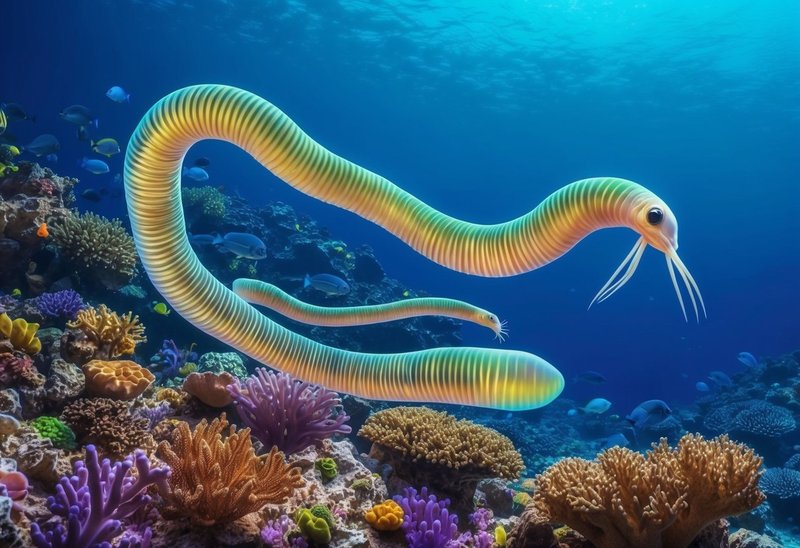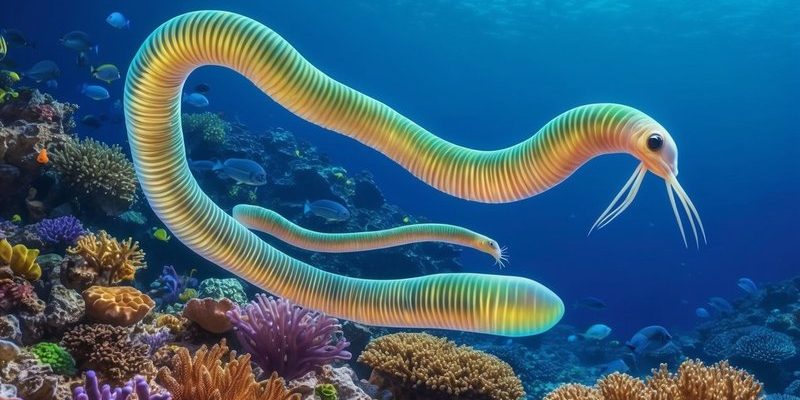
Imagine a Bobbit worm as a stealthy predator, lying in wait like a cunning trapper. This multi-tentacled marine worm, which can reach impressive lengths of up to ten feet, burrows in sandy or muddy seafloors, often camouflaging itself among the sediment. Its remarkable hunting techniques and ecological interactions make it a crucial player in coastal habitats. So, let’s dive in and explore the various roles these worms play in ensuring their ecosystems thrive.
What Are Bobbit Worms?
Bobbit worms, or *Eunice aphroditois*, are segmented worms belonging to the polychaete family. These fascinating creatures are not just your garden-variety worms; they are equipped with long, bristle-covered bodies that can be quite striking in color, ranging from brown to bright green. The name “Bobbit worm” comes from the infamous John Wayne Bobbitt, inspired by the worm’s ability to cut through prey with its sharp jaws.
Typically, Bobbit worms are found in warm tropical and subtropical waters, often residing in areas like coral reefs and seagrass beds. They create U-shaped burrows that serve as both a home and a hunting ground. The way these worms thrive in diverse habitats reflects their adaptability and resilience in marine ecosystems.
You might be surprised to know that Bobbit worms can live for several years, sometimes even decades. That’s a long time to hone their skills! When they’re not hiding in their burrows, these worms stretch their long, comb-like tentacles into the water, ready to grab any unsuspecting fish or crustacean that comes too close.
Predation and Food Web Dynamics
One of the most critical roles Bobbit worms play in coastal ecosystems is as predators. They are opportunistic feeders, meaning they’ll eat whatever comes their way. This ability not only helps control the populations of various marine creatures but also contributes to the overall balance of the food web.
When a small fish or crab swims too near a Bobbit worm’s tentacles, they can be snatched up in a split second. This predation helps regulate the populations of these prey species, preventing any one group from becoming too dominant. Think of it as nature’s way of keeping things in check.
Beyond just being a predator, Bobbit worms also serve as a food source for larger marine animals. Some fish species and sea turtles view these worms as tasty snacks. In this way, Bobbit worms are integral not only as hunters but also as part of a larger cycle of life within their ecosystems.
Burrowing Behavior and Sediment Health
Bobbit worms create intricate burrows in the sediment, which serve multiple purposes. First, these burrows provide the worms with protection from predators and environmental stressors. But they also play a larger role in maintaining sediment health.
As the worms burrow, they mix and aerate the sand and mud. This behavior is crucial for the health of the sediments and helps maintain a balanced ecosystem. Well-aerated sediments allow beneficial bacteria and microorganisms to thrive, which are essential for nutrient cycling in marine environments.
Moreover, the burrowing enhances water flow through the sediment, which can be beneficial for the growth of seagrasses and other benthic organisms. It’s like a natural gardening service that Bobbit worms provide, ensuring that everything from tiny microorganisms to larger plant life can flourish.
Bobbit Worms and Coral Reef Health
Coral reefs are known as some of the most diverse ecosystems on the planet, and Bobbit worms contribute to their vitality in several ways. These worms help control the populations of herbivores, which, if left unchecked, could overgraze the algae that many corals depend on for survival.
Additionally, Bobbit worms’ burrowing behavior can enhance the structural integrity of the reef. As they dig, they help to create spaces for other small organisms, promoting biodiversity. This interaction supports a wide range of marine life, contributing to the overall resilience of the reef ecosystem.
A healthy coral reef is vital for coastal protection, tourism, and even fishing. So, when we appreciate the lush beauty of coral reefs, it’s essential to acknowledge creatures like the Bobbit worm that work behind the scenes to keep this underwater paradise thriving.
Bobbit Worms and Environmental Indicators
Interestingly, Bobbit worms also serve as indicators of environmental health. Their presence, or absence, can tell researchers a lot about the state of the ecosystem. Changes in the population size or health of these worms might signal shifts in water quality or habitat conditions.
For instance, if a Bobbit worm population declines, it might indicate issues like pollution or changes in water temperature. Scientists can use this information to help monitor coastal ecosystems and strive for conservation efforts that safeguard marine life.
So, when you hear about conservation initiatives, remember that monitoring species like the Bobbit worm plays a part in ensuring cleaner, healthier oceans. Understanding these tiny yet mighty creatures is essential for preserving our precious coastal environments.
Threats to Bobbit Worms and Their Ecosystems
Despite their importance, Bobbit worms face numerous threats. Habitat destruction, pollution, and climate change can severely impact their populations. As coastal areas become more developed or changed due to human activities, the delicate balance of ecosystems can be disrupted, affecting everything from the sediment health to the organisms that depend on them.
Another significant threat is overfishing and pollution, which can lead to habitat degradation. When sediment is contaminated or eroded, it can harm the burrowing sites that Bobbit worms need for survival. This, in turn, affects the entire food web, leading to consequences for many marine species.
To combat these threats, conservation efforts focusing on habitat preservation and pollution reduction are crucial. Raising public awareness about the significance of creatures like the Bobbit worm can also foster a greater appreciation for the intricate web of life in our oceans.
Bobbit worms may seem like odd inhabitants of coastal ecosystems, but they play several vital roles that help maintain the balance of marine life. From being effective predators to enhancing sediment health and serving as indicators of environmental quality, these worms are true unsung heroes of the ocean floor.
As we strive to protect our coastlines and the diverse ecosystems they harbor, understanding the ecological importance of Bobbit worms can inspire more significant conservation efforts. The next time you think about coastal ecosystems, remember these fascinating worms and their crucial contributions to life beneath the waves. So, let’s continue to protect and respect our oceans, ensuring that creatures like the Bobbit worm thrive for generations to come.

